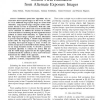Free Online Productivity Tools
i2Speak
i2Symbol
i2OCR
iTex2Img
iWeb2Print
iWeb2Shot
i2Type
iPdf2Split
iPdf2Merge
i2Bopomofo
i2Arabic
i2Style
i2Image
i2PDF
iLatex2Rtf
Sci2ools
PAMI
2011
2011
Motion Field Estimation from Alternate Exposure Images
—Traditional optical flow algorithms rely on consecutive short-exposed images. In this work, we make use of an additional long-exposed image for motion field estimation. Long-exposed images integrate motion information directly in form of motion-blur. With this additional information more robust and accurate motion fields can be estimated. In addition the moment of occlusion can be determined. Considering the basic signal-theoretical problem in motion field estimation, we exploit the fact that long-exposed images integrate motion information to prevent temporal aliasing. A suitable image formation model relates the long-exposed image to preceding and succeeding short-exposed images in terms of dense 2D motion and per-pixel occlusion/disocclusion timings. Based on our image formation model, we describe a practical variational algorithm to estimate the motion field not only for visible image regions but also for regions getting occluded. Results for synthetic as well as real-world...
| Added | 17 Sep 2011 |
| Updated | 17 Sep 2011 |
| Type | Journal |
| Year | 2011 |
| Where | PAMI |
| Authors | Anita Sellent, Martin Eisemann, Bastian Goldlücke, Daniel Cremers, Marcus A. Magnor |
Comments (0)

